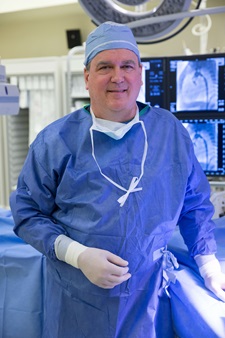A New Emphasis on Treating Adult Congenital Heart Patients
 With more congenital heart disease patients surviving into adulthood, adult survivors of congenital heart disease have long-term medical needs that health care providers are only now beginning to understand. This is why the University of Maryland Medical Center (UMMC) has established a congenital heart program that meets the needs of patients at every age, including adults. More treatment options are being offered for this patient population, including pulmonary valve replacement using a percutaneous catheter.
With more congenital heart disease patients surviving into adulthood, adult survivors of congenital heart disease have long-term medical needs that health care providers are only now beginning to understand. This is why the University of Maryland Medical Center (UMMC) has established a congenital heart program that meets the needs of patients at every age, including adults. More treatment options are being offered for this patient population, including pulmonary valve replacement using a percutaneous catheter.
Earlier this spring, Michael Slack, MD, professor of pediatrics at the University of Maryland School of Medicine and director of Pediatric and Adult Congenital Interventional Cardiology at UMMC, placed a catheter fitted with an artificial valve into the femoral artery of a young adult patient. She’d undergone a Ross procedure several years earlier, but her “new” pulmonary valve had worn out. In the catheterization laboratory, Dr. Slack slowly guided the catheter to the patient’s heart and fitted the artificial valve into place. There was no need to remove the original valve, as the one Dr. Slack used is designed to fit perfectly inside the defunct valve. Dr. Slack then removed the catheter and observed blood was flowing successfully to the lungs. The entire procedure took less than two hours.
It was the first time a right-sided heart valve had been replaced via catheter at UMMC. UMMC is now one of only two hospitals in Maryland with the expertise to perform this procedure.
“We are in the midst of a heart valve revolution in the United States,” says Dr. Slack. “There are more than 20 valves currently in development and all have the potential to dramatically alter the way we currently care for cardiac patients.”
Standard of care for fixing leaky or malfunctioning valves is open-heart surgery. But catheter-based approaches are becoming more common. These non-invasive procedures are much easier to tolerate. “Because patients are living longer, repeat surgeries become riskier each time due to buildup of scar tissue around the heart. But new, non-invasive options such as catheter-based procedures are the wave of the future,” says Dr. Slack.
Patients usually leave the hospital in less than 24 hours and because the valve repair is performed while the heart is still beating, cardiopulmonary bypass is unnecessary. “Patients can get back on their feet in days not weeks,” adds Dr. Slack.
To schedule an appointment with Dr. Slack, please call 410-328-4348.
